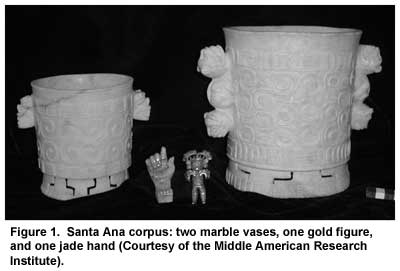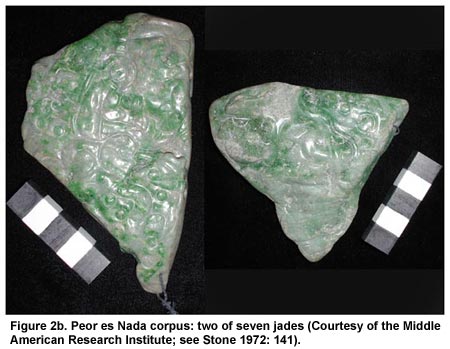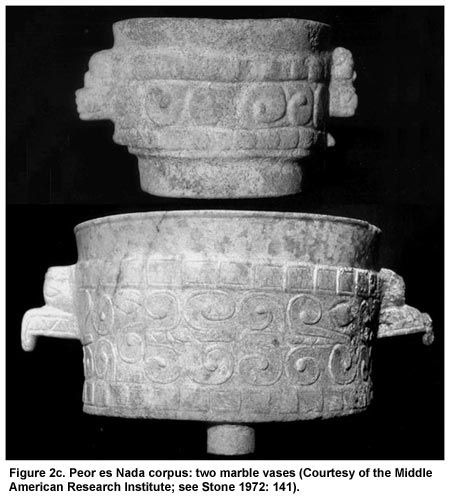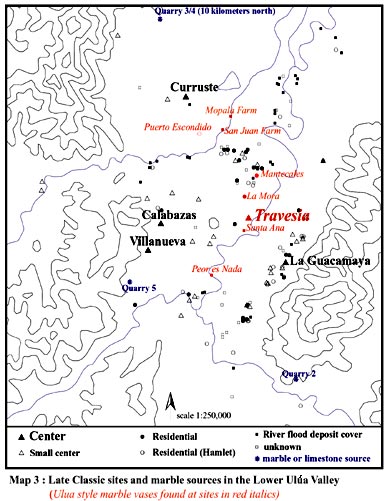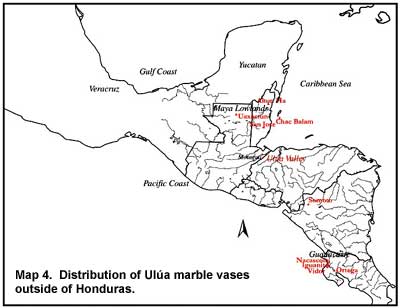
| FAMSI © 2003: Christina Luke |
||
Ulúa-Style Marble Vase Project: Dissemination of Results Late Classic Research in the Lower Ulúa Valley of Honduras Like other lowland Maya regions, the lower Ulúa valley experienced a period of unprecedented growth during the Late Classic period (ca. A.D. 600-800) (Henderson 1997a, 1997b; Joyce 1991). A number of regional centers, located more or less equidistant from each other, were surrounded by smaller centers and hamlets, perhaps wealthy farmsteads. Artifact distribution points to close contact with the neighboring regions of Yojoa and Comayagua to the south and east, with limited direct contact to the west with the Copán valley. The exchange of raw materials, finished products, and stylistic imagery demonstrate foreign ties with communities to the south in regions of El Salvador, Nicaragua, and Nicoya-Guanancaste, Costa Rica and to the north with the central and northern Maya Lowlands (see Henderson 1992a, 1992b, 1988, 1984; Henderson et al. 1982; Hirth 1988; Joyce 1996, 1993b, 1991, 1986, 1985). Late Classic Ulúan communities operated in relatively independent, but clearly overlapping spheres of interaction. Although not united under one political center, communities shared general notions of style, most notably the designs on locally produced painted polychrome pottery (see Joyce 1993b, 1991, 1985). Polychrome iconography drew from local traditions as well as those of greater Mesoamerica (Joyce 1993, 1991; Robinson 1978; Stone 1957; Strong, Kidder and Paul 1938; Viel 1978). Found in all types of contexts, the distribution and access to polychrome pottery does not appear to have been restricted in the region. In fact, production may have been at the household level. Researchers have argued that specific polychrome styles appear to have been used as visual markers for community identity (Joyce 1993b, 1991; Sheptak 1987).
Exotic imports include worked jades, gold objects, Spondylus, green obsidian, and fancy ceramics (Hirth 1988; Joyce 1991). Jade was most likely imported as finished objects and as a raw material subsequently worked in a local style (see Hirth and Hirth 1993).
Shown in Figures 2a-2c: Peor es Nada corpus: seven jades, two marble vases and two polychromes (not shown) (Courtesy of the Middle American Research Institute; see Stone 1972: 141).
Ulúa marble vases are among the locally produced luxury objects and have been found associated with other fancy items including polychromes, jades, and gold objects (Henderson 1992a; Stone 1972, 1977; Schaffer 1992). Unlike polychromes, current data for marble vases indicates that they are found only in special purpose and/or high-status contexts in the valley. And, these marble vases most likely marked one specific community at the site of Travesía, much the way polychrome ceramics functioned as identity tags.
There are approximately 140 whole Ulúa marble vases and fragments located in institutions in the United States, Europe and Central America and a handful in Honduran and Guatemalan excavation depots; an additional 30 to 50 are located in private collections, many of which are on display for the public at museums. This makes the known corpus approximately 200 and attests to the rarity and special nature of the vases.
Of those vases with site provenience, approximately 60% are from the Travesía area, including the nearby sites of Santa Ana, Mantecales, La Mora, Peor es Nada, and Puerto Escondido. Vases are notably absent from the other known regional centers of La Guacamaya, Calabazas, Curruste, and Villanueva. 1 In neighboring regions, vases come from the centers of El Abra (Nakamura 1987), Tenampua, and Salitron Viejo (Hirth and Hirth 1993).
Vases are found at the prominent centers of Nacascolo (Abel-Vidor et al. 1987; Stone 1972, 1977), Vidor, Iguanita (F. Lange, personal communication, 2002) and Ortega (Ferrero 1981) in Guanacaste, and Altun Ha (Pendergast 1990, 1982), San Jose (Thompson 1939) and Uaxactún (Kidder 1947) in the central Maya Lowlands; several vase fragments were excavated in the Motagua valley (G.R. Walters, personal communication, 2002) and one fragment is from Chac Balam (Guderjan 1995).
|
||
|
Text links to all pages at this site are available at the FAMSI INDEX |
||
